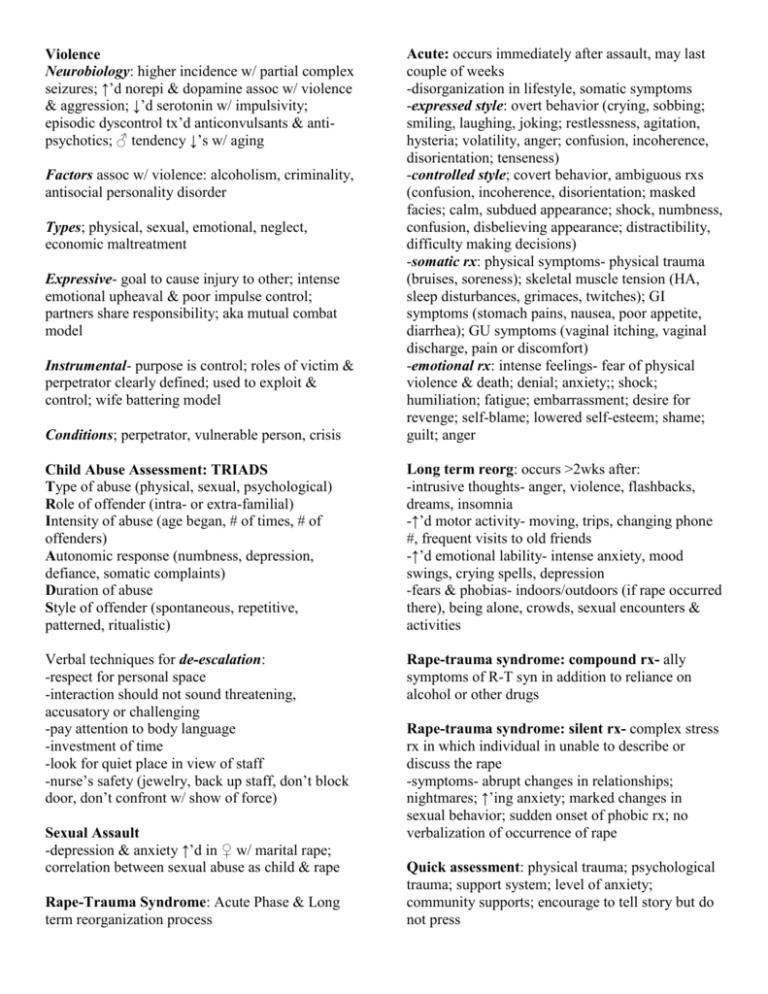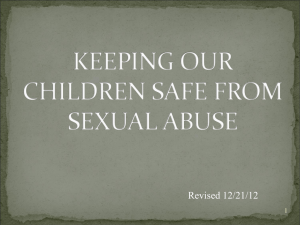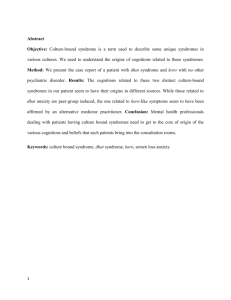NS330 Quiz 6 - WordPress.com
advertisement

Conditions; perpetrator, vulnerable person, crisis Acute: occurs immediately after assault, may last couple of weeks -disorganization in lifestyle, somatic symptoms -expressed style: overt behavior (crying, sobbing; smiling, laughing, joking; restlessness, agitation, hysteria; volatility, anger; confusion, incoherence, disorientation; tenseness) -controlled style; covert behavior, ambiguous rxs (confusion, incoherence, disorientation; masked facies; calm, subdued appearance; shock, numbness, confusion, disbelieving appearance; distractibility, difficulty making decisions) -somatic rx: physical symptoms- physical trauma (bruises, soreness); skeletal muscle tension (HA, sleep disturbances, grimaces, twitches); GI symptoms (stomach pains, nausea, poor appetite, diarrhea); GU symptoms (vaginal itching, vaginal discharge, pain or discomfort) -emotional rx: intense feelings- fear of physical violence & death; denial; anxiety;; shock; humiliation; fatigue; embarrassment; desire for revenge; self-blame; lowered self-esteem; shame; guilt; anger Child Abuse Assessment: TRIADS Type of abuse (physical, sexual, psychological) Role of offender (intra- or extra-familial) Intensity of abuse (age began, # of times, # of offenders) Autonomic response (numbness, depression, defiance, somatic complaints) Duration of abuse Style of offender (spontaneous, repetitive, patterned, ritualistic) Long term reorg: occurs >2wks after: -intrusive thoughts- anger, violence, flashbacks, dreams, insomnia -↑’d motor activity- moving, trips, changing phone #, frequent visits to old friends -↑’d emotional lability- intense anxiety, mood swings, crying spells, depression -fears & phobias- indoors/outdoors (if rape occurred there), being alone, crowds, sexual encounters & activities Verbal techniques for de-escalation: -respect for personal space -interaction should not sound threatening, accusatory or challenging -pay attention to body language -investment of time -look for quiet place in view of staff -nurse’s safety (jewelry, back up staff, don’t block door, don’t confront w/ show of force) Rape-trauma syndrome: compound rx- ally symptoms of R-T syn in addition to reliance on alcohol or other drugs Violence Neurobiology: higher incidence w/ partial complex seizures; ↑’d norepi & dopamine assoc w/ violence & aggression; ↓’d serotonin w/ impulsivity; episodic dyscontrol tx’d anticonvulsants & antipsychotics; ♂ tendency ↓’s w/ aging Factors assoc w/ violence: alcoholism, criminality, antisocial personality disorder Types; physical, sexual, emotional, neglect, economic maltreatment Expressive- goal to cause injury to other; intense emotional upheaval & poor impulse control; partners share responsibility; aka mutual combat model Instrumental- purpose is control; roles of victim & perpetrator clearly defined; used to exploit & control; wife battering model Sexual Assault -depression & anxiety ↑’d in ♀ w/ marital rape; correlation between sexual abuse as child & rape Rape-Trauma Syndrome: Acute Phase & Long term reorganization process Rape-trauma syndrome: silent rx- complex stress rx in which individual in unable to describe or discuss the rape -symptoms- abrupt changes in relationships; nightmares; ↑’ing anxiety; marked changes in sexual behavior; sudden onset of phobic rx; no verbalization of occurrence of rape Quick assessment: physical trauma; psychological trauma; support system; level of anxiety; community supports; encourage to tell story but do not press Rape survivor short term goals: -begin to express emotional rxs & feelings before leaving ED -list psychological rxs possible during long term reorg -state intention to keep f/u appts -anxiety level will lessen from severe to mod before leaving ED Nursing interventions: follow protocol; do not leave client alone; be nonjudgmental; ensure confidentiality; be empathetic; encourage to talk; keep accurate records; engage support system if client permits; emphasize client did right thing to save life; arrange for support f/u Gender identity & sexual disorder: There is no universal “normal”. Normal or satisfying is whatever gives pleasure & satisfaction to those involved w/o threat or coercion or injury to others Biopsychosocial theories Intrapersonal- problems w/ individual; arrested psychosexual dev’t; performance anxiety; fear of intimacy; negative self-concept Behavioral- social learning; conditioned to respond; contributing factors (poor communication skills, concern w/ sexual performance) Sociocultural- based on cultural values & understanding; ethnocentrism; how people communication about sexuality is culturally determined Biologic- neurologic basis for gender differences; prenatal androgen level; adult levels of sex hormones Gender identity disorder- feel intense discomfort in body & have intense desire to be other sex -DSM IV dx criteria: Paraphalias-strong OCD component -fetishism- sex fantasy w/ nonliving objects; not typical to culture; not a problem as long as not harmful w/ consenting adults -transvestic fetishism- men who dress in women’s clothes (vice versa); most have normal sexual relationships & children -sexual sadism & masochism- highly stigmatized in N.Am though ~ 10% participate; usually w/ willing partner -exhibitionism- exposure to unwilling people; usually immature ♂, introverted w/ difficulty relating to adults esp ♀’s; wants surprise, not interested in sex -voyeurism- enjoy watching (peeping toms); generally don’t want to participate -frotteurism- gets pleasure from close physical contact; rub against in elevators, buses, close spaces -pedophilia- adult who is sexually aroused by & engages in sexual activity w/ children; at least 16 yrs old & at least 5 yrs older than child; difficult to tx; very hard to change; tx w/ chemical castration, still repeat offenders Eating disorders Anorexia nervosa- wt 15% or more below min requirements; view selves as fat even when emaciated; much of self-id & success r/t body image; rare in men; not hereditary, more environmental; seen in sports that emphasize thinness -types: restricting type- limit calories; binge/purge type -comorbid w/ dysthymia, major depression; correlation w/ cluster B’s; common sexual abuse history -risk assessment: client’s perception of problem; eating habits; h/ dieting; methods used to achieve control; value attachment; social fxn’ing; MSE -subjective symptoms: terrified of gaining wt; preoccupied w/ thoughts of food; see themselves as fat; peculiar handling of food (cutting in sm bits, pushing around plate); may develop rigorous exercise regimen; self-induced vomiting, laxative, diuretics; cognition so disturbed that self-worth judged by wt -objective symptoms- ammenorhea; dry yellow skin w/ lanugo; recurrent fainting & cardiac dysrythmias; bradycardia; cold extremities; peripheral edema; muscle weakening; constipation; hypotension -dx lab results- T3 & T4 low; EEG abnormalities; impaired renal fxn; dehydration; ↓’d bone density; hypokalemia; pancytopenia -care tips: empathize; do not blame; do not take parental or authoritarian role; goal of tx wt gain (what client fears most) -interventions: assist w/ nutrition teaching; teach parents about disorder, nutrition; schedule time (reduces anxiety, provides control); meal planning; -meds: SSRI’s for relapse prevention when maintenance wt is reached; atypical antipsychotics helpful in improving mood & ↓’ing obsessional behaviors & resistance to wt gain Bulimia nervosa- at or above min wt; purging type or non-purging (fasting or excessive exercise); often abuse substances that effect wt; diffuclty w/ impulsivity & compulsivity -comorbid w/ depression can lead to suicide attempts -tx combination of therapy (CBT) & medsantidepressants (Fluoxetine) -symptoms- tooth erosion, tooth decay; parotid gland swelling; gastric dilation or rupture; calluses or scars on hands (Russel’s sign); peripheral edema; muscle weakening; hypokalemia; hyponatremia; cardiomyopathy; ECG changes; salivary stones -client may experience shame, guilt, out of control feeling Binge Eating disorder- pattern of overeating w/o compensatory behaviors -frequently a symptom of affective disorder (depression) -tx- SSRI’s (Zoloft) & CBT Crisis- major stressor or life change; 3 typesmaturational, situation, adventitious -maturational- time when adaptation & adjustment to new responsibilities are necessary -situational- event that poses threat or challenge to an individual -adventitious-disaster, not part of everyday life; unplanned & accidental; natural (fire, flood), national (war, terrorism, plane crash), crime of violence (rape, murder, bombing in crowded area) -community- effects entire community -cultural- person experiences culture shock in process of adapting to new culture Four phases of crises: -phase I- threat results in anxiety; client uses avail coping skills to overcome -phase II- ↑’d anxiety, ↓’d ability to cope; trial & error attempts -phase III- use of whatever means necessary to bring anxiety under control; automatic relief behaviors (withdrawal &flight);cognitive skills to redefine crises & counseling are used -phase IV- panic state; can result in depression or psychosis *want to resolve @ phase I; III & IV require intervention Factors affect coping: # of current stressors; unresolved losses; comorbid psych or med disorders; excessive fatigue or pain; environment Hans Selye’s Stress Theory: persons have different abilities to respond -general adaptation syndrome- bodies rx to stress; “fight or flight” 1.alarm rx; ↑ adrenaline, primal rx 2.resistance: remain until crisis resolves itself 3.exhaustion; body can no longer maintain resistance Nurses role in crises: psych assess (clients perception, situational supports, coping skills); plan for recovery; implement plan; eval outcome -persons; equilibrium can be affected by: unrealistic perceptions of event; inadequate situational support; inadequate coping skills -nurse problems- needing to be needed; unrealistic goals for client; difficulty dealing / suicide; difficulty terminating Rules for nursing intervention: client is in charge & able to make decisions; nurse pt relationship is a partnership; client safety & anxiety reduction guide initial intervention Critical Incident Stress Debriefing (CISD)tertiary intervention for group that has experienced crisis; 7-phase group meeting offers opportunity to share thoughts & feelings; -phases: introductory, fact, thought, reaction, symptom, teaching, reentry Complimentary therapies Relaxation-progressive muscle relaxation (PMR); countdown, guided imagery Hypnosis- assistance of client to altered state of consciousness, to create focused experience Massage- stimulation of skin & underlying tissues to ↑ circulation, induce relaxation response Music therapy- specific types of music to effect changes in behavior, emotions & physiology Pet therapy- use of animals to provide affection & attention as well as diversion Anger control- teaching aimed at helping clients to facilitate anger in an effective way; nurse attempts to learn client’s triggers; provide healthy outlets such as physical exercise or journaling










